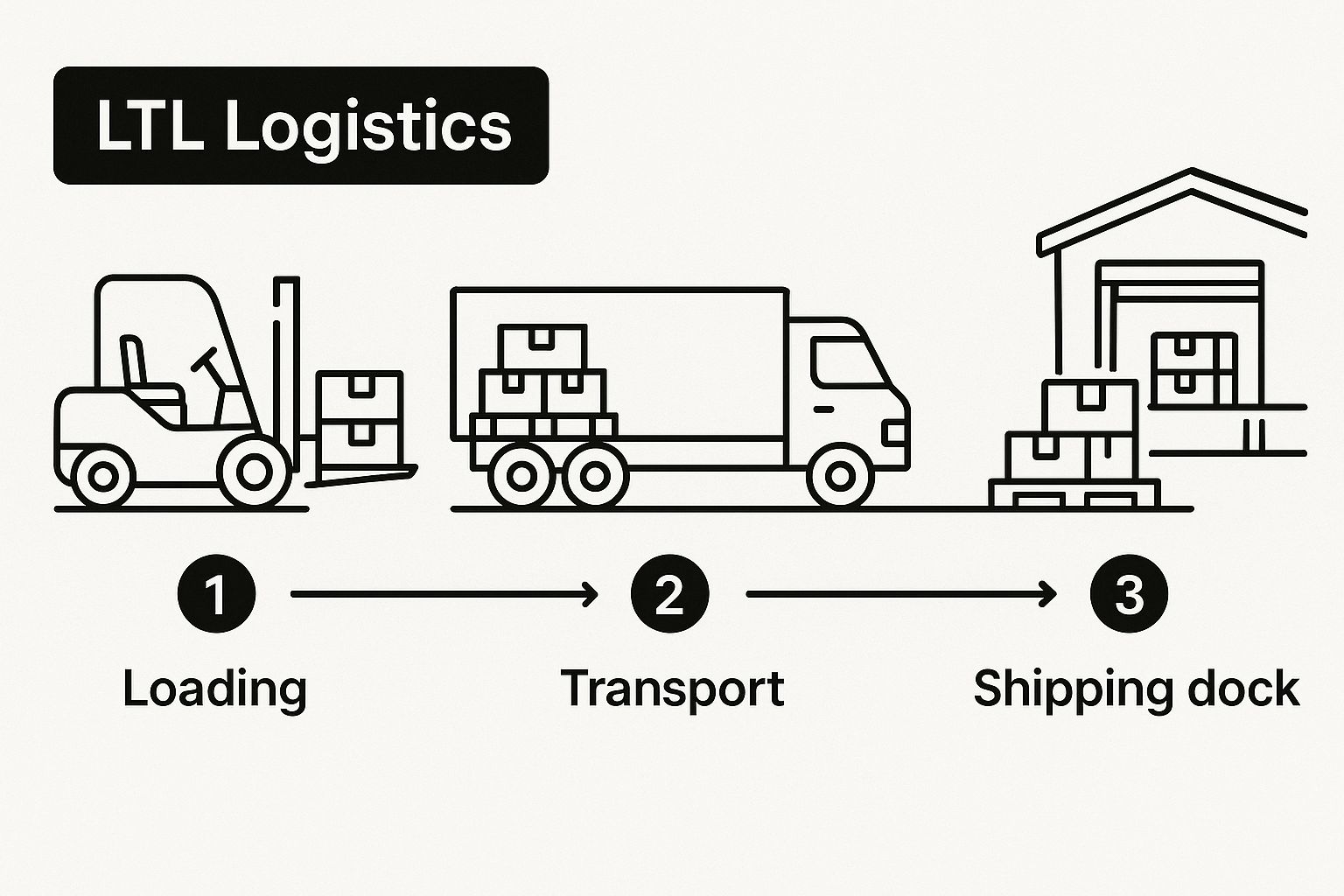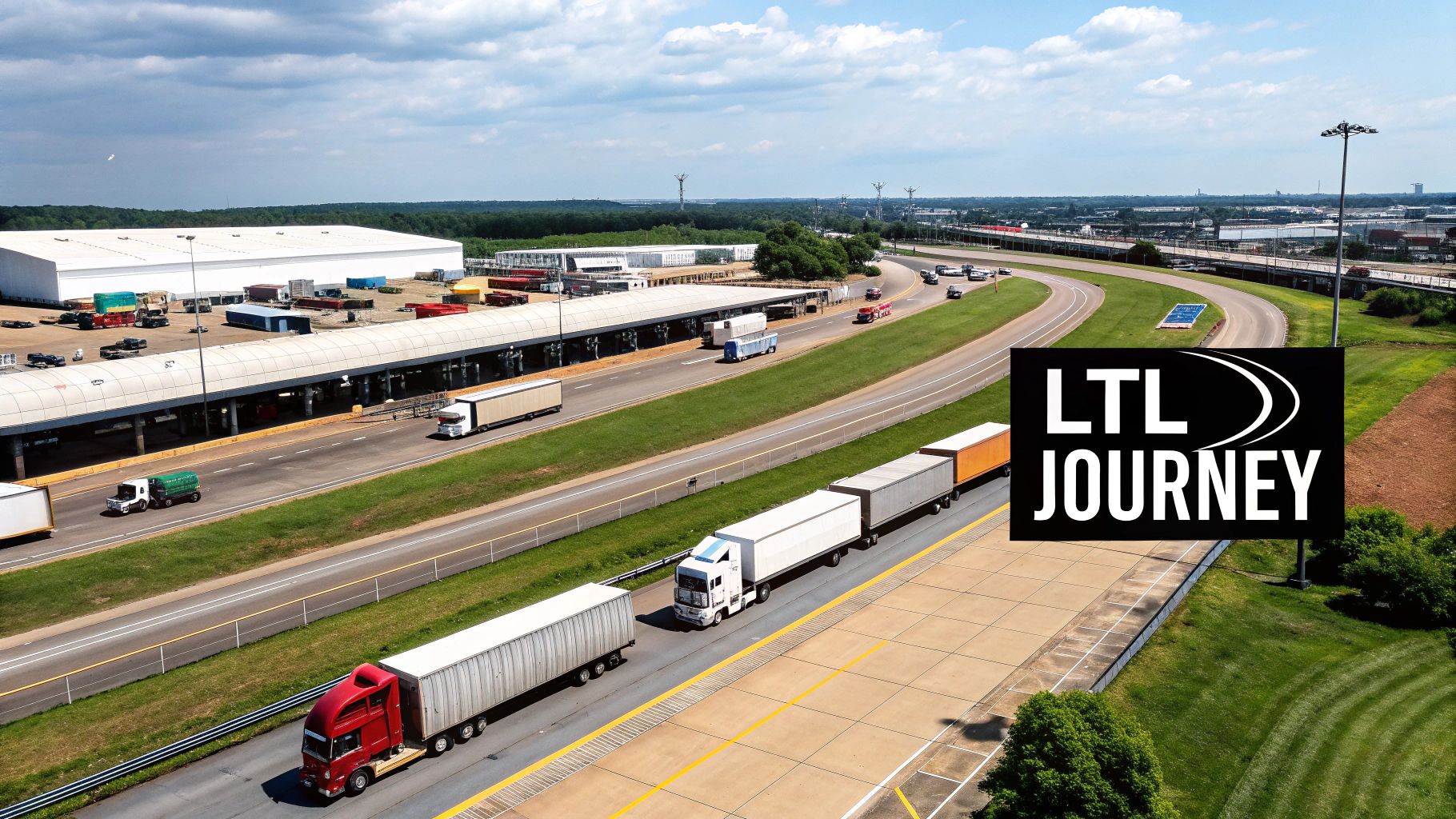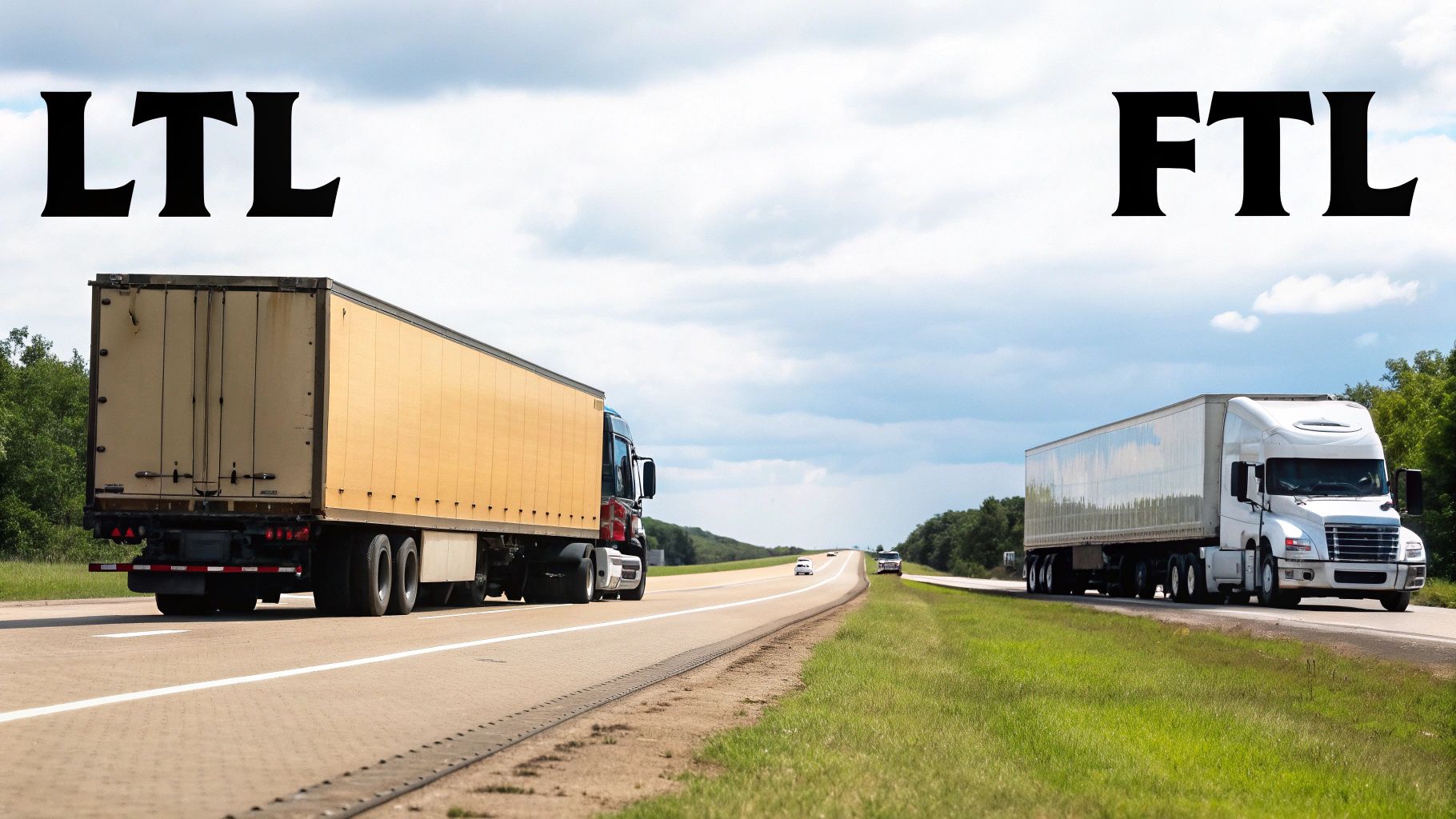What is the LTL definition logistics? This guide explains less-than-truckload shipping with clear examples, benefits, and how it saves your business money.

Ever find yourself with a shipment that's too hefty for a standard parcel carrier but not nearly enough to fill an entire semi-truck? You're not alone. This is a common scenario in the world of shipping, and it's exactly where Less-Than-Truckload (LTL) shipping shines. It’s a smart, budget-friendly way to move your goods by sharing truck space—and the cost—with other shippers.
Think of LTL shipping like a carpool for your products. Instead of booking and paying for an entire bus when you only need a couple of seats, you just pay for the space your items take up. Simple, right? This approach is a lifesaver for businesses shipping smaller batches of goods, making professional freight transportation both accessible and affordable.
At its core, LTL is an efficient system built to combine multiple smaller shipments from different companies into a single truck heading in the same general direction.
The beauty of the ltl definition logistics lies in this shared-space model. It’s a freight transportation method where multiple shipments, typically weighing between 150 and 15,000 pounds (or spanning one to six pallets), are consolidated for transit. This is the complete opposite of Full Truckload (FTL) shipping, where one shipper’s freight occupies the entire trailer.
To make this happen, LTL logistics relies on a "hub-and-spoke" network. Your freight travels through a series of terminals and cross-docks before it reaches its final destination, kind of like a passenger changing planes at a connecting airport.

When it comes down to it, LTL shipping is all about maximizing efficiency. By consolidating freight from various shippers, carriers make sure their trucks are running as full as possible, which is good for their bottom line and yours.
This entire operation is managed by a specialized LTL carrier. These are the companies that orchestrate the complex dance of pickups, consolidations, and deliveries. If you want to dive deeper, you can explore our guide on what is an LTL carrier.
To give you a quick, easy-to-digest summary, here's a table that breaks down the fundamentals of LTL shipping.
This table provides a snapshot of the core features of LTL shipping, defining its key operational parameters.
In short, this table captures the essence of LTL: it's a flexible, cost-effective shipping method built for smaller freight loads that don't require a dedicated truck.
So, your pallet is loaded and the truck is pulling away from your dock. You might think it's a straight shot to its destination, but its real adventure is just beginning. LTL shipping isn't about direct routes; it's a masterclass in efficiency, built around a network that keeps costs down.

The whole system runs on what the industry calls a hub-and-spoke model. The easiest way to picture this is to think about how airlines work. Flying from a small city to another small city? You probably won't find a direct flight. You'll fly from your local airport (a "spoke") to a major hub like Atlanta or Chicago, switch planes, and then head to your final destination.
LTL freight operates on the exact same logic. Your shipment will travel through several terminals, getting sorted and combined with other freight heading in the same general direction. This shared ride ensures trucks are as full as possible, and that’s precisely what makes LTL so budget-friendly.
Let's pull back the curtain and trace the typical path your shipment takes. Each step is a crucial part of the puzzle, making sure your goods get from A to B safe and sound.
Curious how much this efficient journey could save you?
Throughout this entire multi-step process, there's one document that acts as your shipment's passport, contract, and receipt all rolled into one: the Bill of Lading (BOL).
The Bill of Lading (BOL) is a legally binding document that outlines all the critical details of a shipment. It specifies the shipper and receiver, what the goods are, their weight and dimensions, and the all-important freight class.
Here’s a piece of advice from someone who’s seen it all: get the BOL right. Being accurate on this document is absolutely non-negotiable. One small mistake—like an incorrect weight or the wrong freight class—can trigger expensive re-billing fees, cause frustrating delays, and create a lot of headaches. If you want a smooth, predictable shipping experience, making sure your BOL is perfect is the best thing you can do.
https://www.youtube.com/embed/RcOnNBMyui4
Ever wondered why two shipments with the exact same weight can have wildly different shipping costs? It's not just about the distance. The real answer lies in a core concept of the LTL world: freight class.
Think of it as a standardized pricing system that gives every shippable item a category. This system, run by the National Motor Freight Traffic Association (NMFTA), is all about making sure shipping prices are fair and consistent. It prevents a pallet of dense, sturdy steel parts from costing the same as a pallet of bulky, fragile lampshades, even if their weights are identical. The lampshades simply take up more room and are far more likely to get damaged, making them a bigger risk to transport.
Honestly, understanding your freight class is probably the single most important thing you can do to get a handle on your LTL shipping budget.
Not sure where to begin with calculating your costs? Getting an instant quote is the fastest way to see how these factors come together.
So, how does the NMFTA figure out where your goods belong? It all boils down to four key characteristics of your shipment. By evaluating these four factors, they assign your freight a number between Class 50 (the cheapest) and Class 500 (the most expensive).
LTL freight rates are complicated, and these four factors are the heart of the pricing model. For shipments that typically fall between 150 and 10,000 pounds, their rates are determined by this classification system. It’s a scale with 18 different classes that balances density, stowability, handling, and liability to come up with the final cost. To get another perspective on this, you can discover more insights on what impacts LTL rates from Logistics Plus.
Key Takeaway: The lower your freight class number, the lower your shipping rate will be. A great way to lower your class is to improve your freight's density. For example, packing items more tightly on a pallet reduces the overall volume, which can make a real difference.
If you want to get into the nitty-gritty, our complete guide on how freight class is determined is a great next step. Mastering this concept gives you the power to pack smarter, ship more efficiently, and ultimately, save a lot of money.
So, you're standing at a crossroads, trying to figure out if you need to book a whole truck or just a slice of one. This is one of the most common decisions in shipping, and the right answer can make a huge difference to your budget, delivery schedule, and even how safely your freight arrives.
This all comes down to the classic matchup: Less-Than-Truckload (LTL) versus Full-Truckload (FTL).

Let's break it down with a simple analogy. Think of LTL shipping like carpooling—you and a few others are heading in the same general direction, so you share the ride and split the cost of gas. FTL, on the other hand, is like calling a private car service; the entire vehicle is yours, dedicated solely to your trip.
Each one has its place, and knowing when to use which is a cornerstone of smart logistics.
The choice really boils down to four key factors: the size of your shipment, your budget, how fast you need it there, and how delicate it is. LTL is a fantastic money-saver for smaller loads, while FTL offers the speed and security of a dedicated ride.
To make it even clearer, we've put together a simple table to help you see the differences side-by-side.
Looking at them this way, you can start to see which one aligns better with what you're trying to accomplish.
So, how does this all play out in the real world? The right choice usually becomes pretty obvious once you look at the specifics of your shipment.
If you’re sending a smaller load (think less than six pallets) and you have some wiggle room on the delivery date, LTL is almost always going to be your most cost-effective option. It gives you access to a massive shipping network without having to pay for a dedicated truck.
On the flip side, FTL is the clear winner in a few key situations:
Want to get a better handle on dedicated freight? Take a deeper look into the world of full truckload shipping in our detailed guide. Mastering this choice is a fundamental skill for anyone managing logistics.
Choosing LTL shipping is more than just a way to get your products from A to B. It’s a smart business move that can inject some serious efficiency and agility into your supply chain. While the upfront cost savings are what grab most people's attention, the real benefits go much deeper, helping your business stay lean and react faster to what your customers want.
Let's start with the most obvious win: cost efficiency. When you ship LTL, you're essentially splitting the bill for the truck with other shippers. You only pay for the space your freight takes up, which is a huge deal for companies that don't have enough product to fill an entire trailer every time. It turns a massive fixed cost into a much more predictable variable expense.
Curious what those savings might look like for you? You can find out in just a few minutes.
Beyond just saving money, LTL gives you an incredible amount of flexibility. It lets you send out smaller shipments more often, which can completely change how you manage your inventory. Instead of sitting on products, waiting until you have enough to justify a full truck, you can get orders out the door as soon as they’re ready. That means less cash tied up in inventory and happier customers.
This model is a massive engine for the U.S. economy. The LTL industry’s knack for handling all sorts of shipping needs is what keeps things moving, with the top 25 carriers commanding about 91% of the market revenue. This creates a reliable, nationwide network that businesses can tap into to fine-tune their logistics. If you're interested in the numbers, you can discover more about the LTL market's role on IBISWorld.
LTL carriers also offer a whole menu of helpful services that can be tricky to arrange with a full truckload. Think of these as tools that help you serve more customers in more places.
And to top it all off, there's a nice environmental perk. By sharing truck space, we're putting fewer trucks on the road to move the same amount of stuff. This consolidation directly translates to less fuel being burned and a smaller carbon footprint for your business.
Jumping into the world of LTL shipping can feel like learning a new language. To help you get your bearings, we’ve put together answers to some of the most common questions we hear every day. Think of this as your LTL cheat sheet.
We’ll cover everything from getting your freight ready for the road to what to do when things don’t go as planned. Let's dive in.
This is a big one. Getting your freight prepped correctly is the single best thing you can do to prevent damage and avoid surprise fees. First, everything needs to be securely packed onto a standard pallet.
Once it's packed, you'll want to use shrink wrap to bind it all together into one solid, stable block. You don't want anything shifting or toppling over on the truck. Then, make sure you label each pallet clearly with both the shipper's and the receiver's addresses.
And here’s a crucial tip: weigh and measure your shipment after it’s fully packed and on the pallet. These final numbers are what the carrier needs for an accurate quote. Getting this wrong is a surefire way to get hit with an unexpected re-billing fee.
Ever wonder how a driver gets a heavy pallet off the truck without a loading dock? That’s where a liftgate comes in. It's a hydraulic platform on the back of the truck that acts like an elevator, safely lowering freight from the truck to the ground.
You'll definitely need to ask for a liftgate service if the pickup or delivery location is a:
Forgetting to request a liftgate when you need one is a common and frustrating mistake. It almost always leads to a failed pickup, delivery delays, and extra charges. Be sure to mention it when you book.
It’s rare, but it can happen. While carriers are pros, trucks move, and freight gets handled a lot in the LTL world. If you discover your shipment is lost or damaged, the very first thing you need to do is file a freight claim with the carrier.
Pro Tip: Always, always inspect your freight before you sign the delivery receipt. If you see even a little bit of damage—a dented box, torn wrap—make a note of it on the receipt right then and there. Snap a few pictures with your phone, too. This documentation is your most powerful tool for getting a claim approved.
Get in touch with your freight broker or the carrier as soon as you notice a problem to get the ball rolling. Just remember, a carrier's standard liability is usually limited. If you're shipping something valuable, it’s always a good idea to buy extra freight insurance to make sure you're covered for its full value.
At FreightQuotesNow, we sweat the details so you don't have to. Our team is here to help you get LTL right, finding you the best rates and services for every shipment.